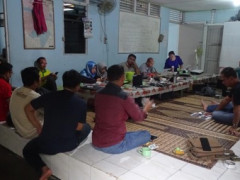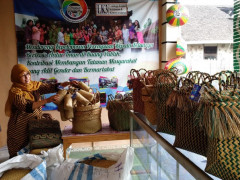Synergy in West Kalimantan Regional Consultation
By Simpul Jaringan Kalimantan BaratThose Who Live in Peatlands
Peatlands offer not only a vast overlay of carbon gold, but also a home for a wealth of flora and fauna. When visiting Sebangau National Park, the Pantau Gambut monitoring team came face-to-face with animal and plant species they had never seen before.
This abundance of rare flora and fauna is made possible by the unique characteristics of peatland, including acidic pH, limited nutrients, dense organic matter, and high water density. This is why only certain flora and fauna can adapt to these conditions.
Studies about biodiversity in peatlands have been conducted since the era of Dutch colonialism, beginning with Ijzerman in 1895. Peatlands generally host less diverse flora than tropical rainforests. However, the flora in peatlands have more varied characteristics than the flora of other ecosystems in the same biogeographical zone. The vegetation diversity in peat ecosystems is closely related to peat density. The more dense the peat becomes, the less vegetation grows over it, because such vegetation must rely on rainwater for nutrients.
Vegetation is most diverse in shallow peatland, commonly known as mixed forest, which consists of large trees and dense plants.
The habitat surrounding a peat dome, known as deep peat forest, supports less diverse vegetation. The habitat on a peat dome, known as padang forest, has very little vegetation diversity, consisting of small, low-density trees.
Indigenous plant species found in peatlands include ramin (gonystylus bancanus), jelutong (dyera costulata), punak (tetramerista glabra), crepe myrtle (lagerstroemia speciosa), and dark red meranti (shorea pauciflora).
In addition to flora, peatlands are also home to a wealth of fauna, including terrestrial and aquatic animals. According to 2009 data from the WWF (published by CIFOR), 35 mammal species, 150 bird species, and 34 fish species reside in peatlands. Some of these were endemic or protected species, including false gharials, langurs, orangutans, Sumatran tigers, and honey bears.
Indonesia’s most biodiverse peatland area is in Sebangau National Park in Central Kalimantan. Eight hundred and eight species of flora, 35 mammal species, 182 bird species, and 54 snake species inhabit the area. Unfortunately, the survival of many of these species is threatened by the conversion of peatland into plantation and settlement areas and other activities that could trigger forest and land fires. This vulnerability affects the sustainability of biodiversity in peatlands, which is why the Indonesian government issued Regulation No. 71/2014 regarding the Protection and Management of the Peat Ecosystem.
Peat ecosystem protection and management have become important not only for ecological reasons, but also for economic, social, and cultural considerations.
Local communities depend heavily on peatland, because its biodiversity sustains their livelihoods. Peatland provides them with timber and agricultural products such as fish, mushrooms, medicinal plants, and honey for sustenance.
Therefore, let us support the regulation of peat ecosystem management and protection to preserve diverse flora and fauna and support the prosperity of local communities!




